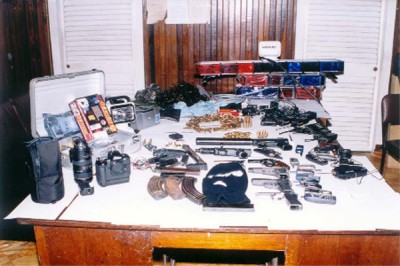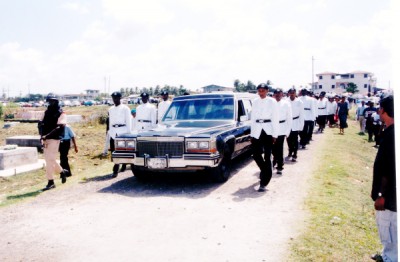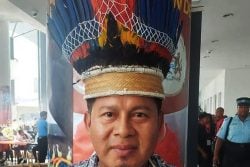Guyana’s gangs have participated in diverse criminal activities − armed robbery, murder,
narcotics-trafficking, gun-running and piracy − over the past decade. Serious crime has become more pervasive and continues to rise, making the country more unsafe. Can the gangs be dismantled?

Head of the Guyana Police Force Criminal Investigation Department Seelall Persaud recently confessed that criminal gangs have been “causing headaches for the police force.” Despite dismantling some gangs and seizing illegal guns at a rate of nearly three per week, he reported that the surge in gang-related violence and organised narcotics and firearms trafficking were the main factors triggering a 36 per cent increase in general crimes, and nine per cent in serious crimes, including murders. The high incidence of gang-robberies and the use of illegal firearms, Persaud says, contributes to “a very high level of violence and fear within the society.”
Gangrene
The gangrene of gang violence is eating away at legitimate economic development and social stability all over the country and has challenged the police force’s capability to control crime. Gangs are involved in robberies, narcotics-trafficking and firearms-trafficking and have targetted bank customers and businesses that still store large amounts of cash on their premises.

In the hinterland, the massacres at Bartica and Lindo Creek − which are both located in the police ‘E’ and ‘F’ interior divisions − accounted for over 26 per cent of murders in the entire country so far this year. Gangs operate on the waterways as pirates and, although piracy has been a major public safety problem for decades, repeated reports of raids and the recovery of the cadavers of seamen washed up on the foreshore place maritime piracy in the same category as rural and hinterland banditry. Most attacks have been perpetrated against Guyanese victims, by Guyanese criminals, in Guyanese waters. The murderous behaviour of gangs of Corentyne pirates has been established by the occasional arrests by Surinamese authorities of the culprits.
Elsewhere, large gangs of criminals have been implicated in Guyana Revenue Authority busts of contraband beverages, Guyana Energy Agency busts of illegal fuel, Customs Anti-Narcotics Unit busts of cocaine traffickers, and Guyana Police Force busts of everyday crooks. The construction of the 1,100-metre, illegal aerodrome at Wanatoba, about 135 km upriver from the Orealla Village on the Corentyne River, gives a good idea of the geographical and logistical reach of Guyana’s gangs. The cartels that control narcotics-trafficking that involve transnational transactions which require a great deal of international coordination, precision planning, organising, financing and recruiting of a loyal labour force, exemplify Guyanese criminal expertise.
Discoveries of huge arms caches, from time to time, have pointed to the existence not only of the large number of illegal weapons but also to the large number of gangs, some of which employed serving members of the police force. One such gang was detained on December 4, 2002 by a Guyana Defence Force patrol and handed over to the police following the discovery of a cache of arms and electronic surveillance equipment in a pick-up at Good Hope, East Coast Demerara. The charges brought against the gang were all dismissed by magistrate Jerrick Stephney. Another gang was surprised on September 1, 2004 in Bel Air Village also had a large cache of illegal weapons. The charges, similarly, were dismissed by magistrate Adrian Thompson.
The violent criminal assault at Grant 1805 at Crabwood Creek in early August 2006 and the ambush of a MMC Security Force squad by a gang of bandits − in which two security guards were killed in broad daylight in the vicinity of the Sheribana Bridge on the Essequibo River − indicate the ability of the gangs to strike anywhere in the country.
Origins
But what is behind this sustained and rising wave of criminal violence? Although it is evident that the current crime wave started on February 23, 2002 with the Mashramani breakout of the ‘gang of five’ from the Georgetown prison, the reasons for the subsequent scale, scope and size of the criminal enterprise are not so clear.
Three months after the breakout, Dr Roger Luncheon – who is Head of the Presidential Secretariat, Secretary to the Cabinet and Chairman of the Central Intelligence Committee – seemed to have been convinced about two things. First, that the crime wave was drug-related. Second, that it was gang-related. He told the media in May 2002, that the violence was “of extreme concern both to the administration and the narcotics interdiction agencies.”
It was Dr Luncheon himself who can claim authorship of the expression ‘phantom’ force to describe the gangs responsible for the perpetration of certain crimes, particularly murders. In November 2002, he took the trouble to explain that the original members of the ‘gang of five’ were not the only ones responsible for the surge in crime. He declared then that there was “plausible evidence to suggest that there is a body out there that is involved in criminal activities and that it is not the escapees and those who have been associated with the escapees.”
By the time of the Diwali massacre of November 2002, ‘phantom’ gangs had killed four of the five escapees, without making any arrests. As the Buxton-Friendship-based gang of escapees recruited more acolytes, so-called suspects were discovered dead, some with marks of torture. Prominent among the second generation of gangsters who inherited the original criminal enterprise of the ‘gang of five’ was Rondell Rawlins, nicknamed ‘Fineman.’
Any mystery about the phantom gangs disappeared in October 2003 when George Bacchus made the startling public admission that he was a member of one of those very gangs. Rather imprudently, he threatened to expose the gang’s links to a senior government official but, before he could appear at a commission of inquiry into those allegations, he was shot dead in his bed on the night of June 24, 2004.
Opinions
Disregarding the Central Intelligence Committee’s analysis, and ignoring the Criminal Investigation Department’s evidence of the complexity and variety of
criminal violence, certain politicians have found it expedient to attempt to describe the emergent gang activities as political.
Presidential Adviser on Governance Gail Teixeira, for example, expressed the opinion that this country is confronted by politically-motivated criminal gangs that are bent on terrorism. When Prime Minister Samuel Hinds said that the Lusignan massacre in January 2008 was “clearly a racial problem,” Teixeira, quickly disagreed, interjecting that the gang had a ‘terroristic agenda’ and pointing out that terror was based on creating fear and trying to create tension between different ethnic groups. She said then “The issue of whether the gunmen who attacked Lusignan are one ethnic group or not is not the issue…we can’t tell that as we weren’t there…The point is somebody is leading this group with extremist views who want to create ethnic instability in Guyana between the different ethnic groups.”
Last March, Minister of Home Affairs Clement Rohee expressed the similar view that the gangs that had been killing and robbing “were politically-motivated.” He added, “After all, how can we explain their activities in the context of the criminal enterprise with heavily armed AK-47s and other automatic and semi-automatic weapons, the hiring and paying of lookouts and informants, as well as financing persons to provide transportation to move stolen weapons? Certainly these are no ordinary criminals who as some claim have a just cause.”
But, is it not a question of criminal commonsense, rather than high political theory, for gangs to arm themselves, provide lookouts and informers and arrange transportation and communications? Now that the specific Agricola-Buxton gang which officials had blamed for all three of this year’s massacres – Lusignan, Bartica and Lindo Creek – has been eliminated, how will officials explain other gang-related crimes?
Rohee had rashly compared the March 2007 raid by an armed gang at Lesbeholden in Black Bush Polder to the October 2006 raid at Mon Désir in the Canal No 2 Polder on the West Demerara. The police promptly pronounced that their enthusiastic and fantastic ballistic tests on spent shells found at Lesbeholden proved that the “same guns” had been used not only at Mon Désir but also in the mass murders of Minister of Agriculture Satyadeow Sawh, his relatives and security guard at La Bonne Intention in April 2006 and at Agricola in February 2006. When the gang of five men accused of the Lesbeholden rampage were arrested and appeared at the magistrates’ court, however, both Rohee’s thesis and the police hypotheses which tried to link a single gang with crimes at Mon Désir, La Bonne Intention, Agricola and Lesbeholden collapsed.
Policing
The administration’s attitude, and the police attempts, to curb criminal gangs have been highly unsuccessful because they have been manifestly misinformed and politically misguided. As a consequence, criminal gangs involved in piracy, fuel-smuggling and narcotics-trafficking have not been pursued with great zeal. This failure ignores the fact that those contraband crimes are connected to the violent crimes such as gun-running and robberies. It is now increasingly clear that the Bartica and Lindo Creek massacres, for example, were neither politically nor racially motivated.
The administration’s anti-gang strategy has been fundamentally flawed. It has failed in eliminating, but sometimes succeeded in stimulating, the gangs they targeted, and in alienating the communities in which they were operating. The police mistakenly target certain types of persons who are not themselves engaged in criminal action thus eliminating them as potential agents of cooperation. The bizarre Operation Stiletto on October 24, 2005 in which twelve dozen persons from Buxton-Friendship were arrested, and the equally absurd July 29-31, 2008 arrest of six dozen youths from Agricola-Mc Doom community − to be screened, photographed and fingerprinted − for example, severely damaged the perceptions of the police as an impartial, law-enforcement agency. They also showed how grossly unprepared the police force is to collaborate with residents or respond to the problems caused by gangs.
Now that the so-called Agricola-Buxton gang has been broken and its notorious leader has been killed, the administration and the security forces should take a less hysterical approach to the problem. Gangs should be examined clinically and dismantled intelligently by removing the causes – economic, geographical, governmental, social or political – which brought them into existence in the first place. As the police report has shown, gangs are not necessarily tightly organised and there is no basis for the popular belief that most gangs come from Agricola or Buxton villages. In reality, some gangs are loose networks with shifting membership and uncertain leadership that are prepared to seize opportunities as they present themselves.
Gangs are not going away of their own accord but, if they are to be dismantled, the police must change their strategy. Weekly police reports indicate how easily groups come together, acquire firearms and commit crimes – sometimes clumsily but frequently fatally. Without empirical evidence and intelligent analysis, it is unwise and unhelpful for decision-makers to loudly give the impression that criminal gangs conform to someone’s pet political theory. If the police want their crime-fighting strategy to have any redibility, they have an obligation to be objective and to base their plans on a sound evidential foundation rather than political old talk.
The people want the police to arrest criminals, dismantle gangs, reduce organised crime and restore a satisfactory level of public safety to the whole country.





